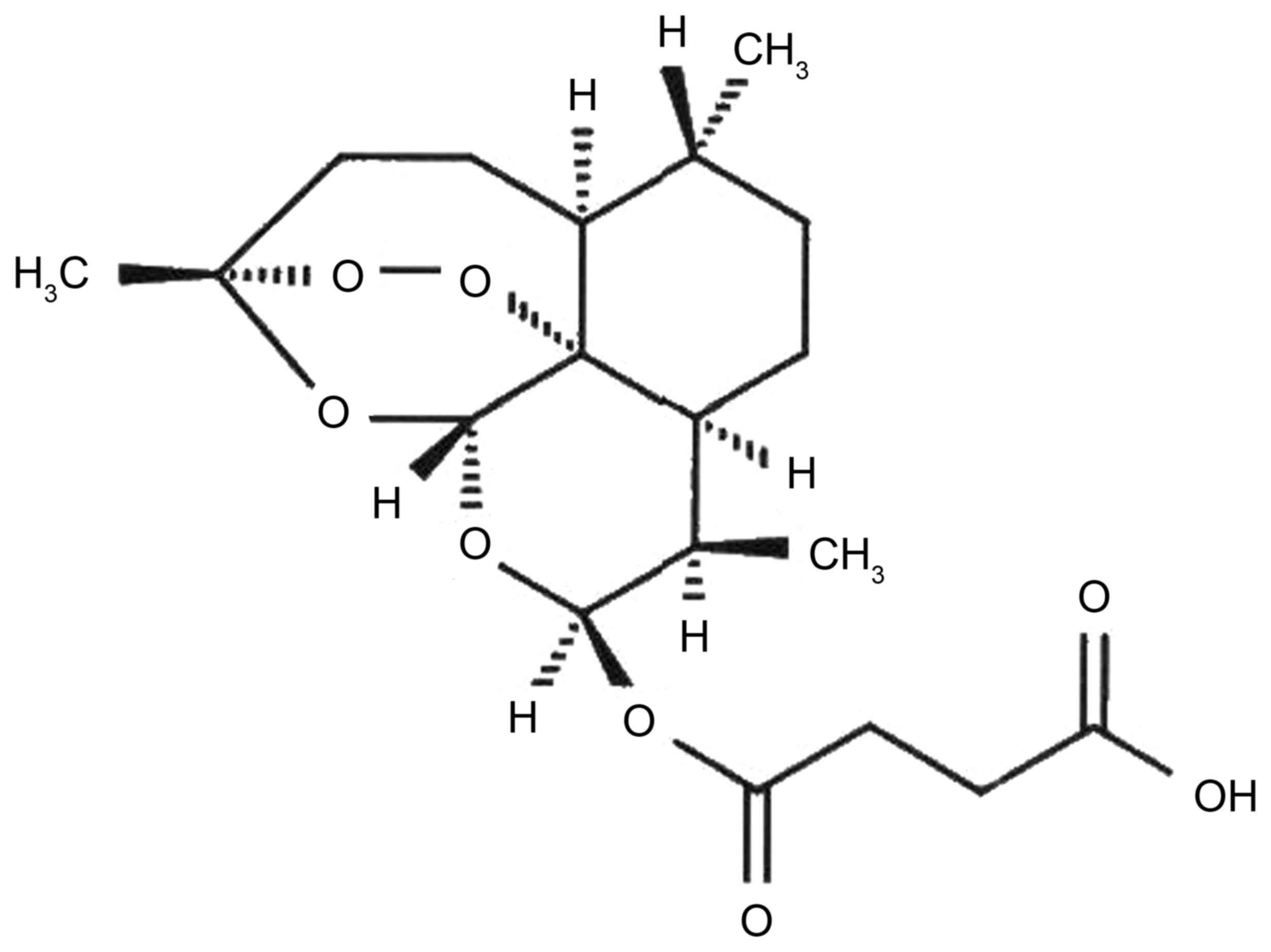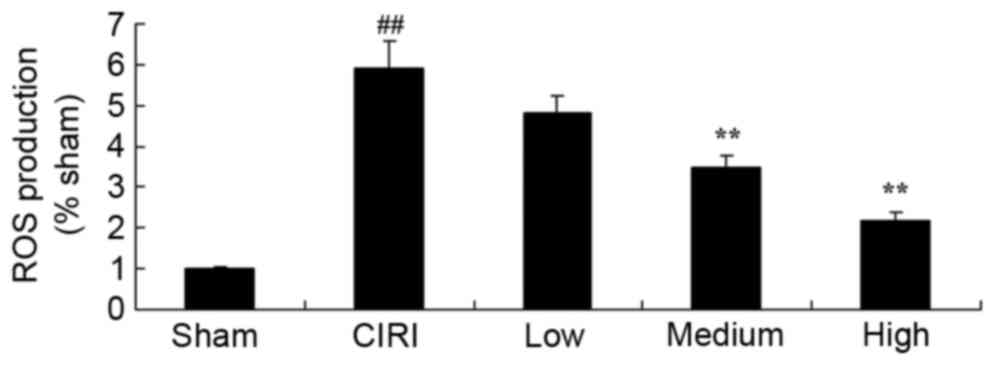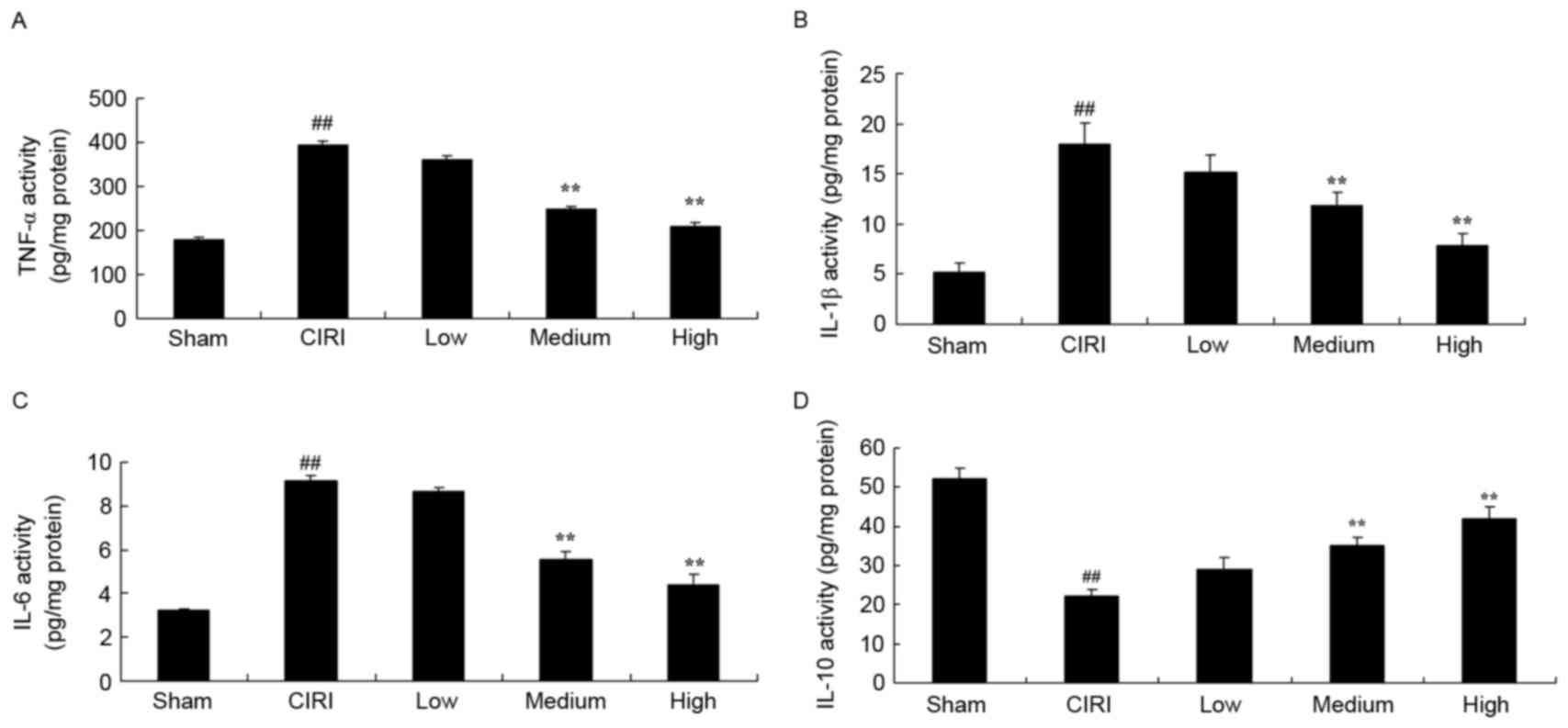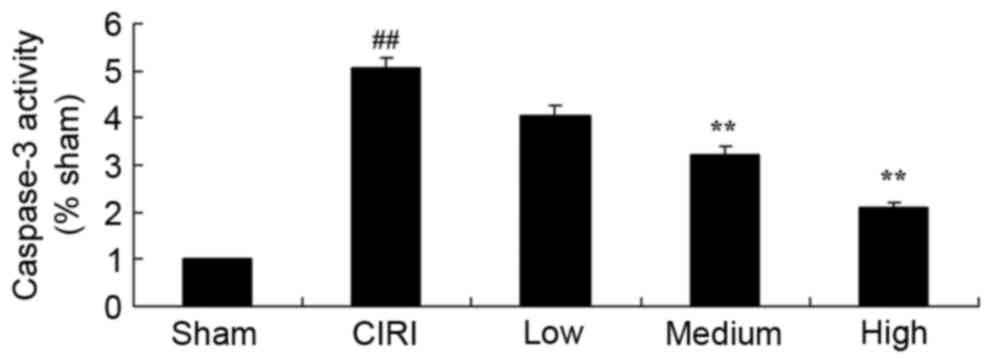|
1
|
Sorond FA, Tan CO, LaRose S, Monk AD,
Fichorova R, Ryan S and Lipsitz LA: Deferoxamine, cerebrovascular
hemodynamics, and vascular aging: Potential role for
hypoxia-inducible transcription factor-1-regulated pathways.
Stroke. 46:2576–2583. 2015. View Article : Google Scholar : PubMed/NCBI
|
|
2
|
Kernan WN, Viscoli CM, Furie KL, Young LH,
Inzucchi SE, Gorman M, Guarino PD, Lovejoy AM, Peduzzi PN, Conwit
R, et al: Pioglitazone after ischemic stroke or transient ischemic
attack. N Engl J Med. 374:1321–1331. 2016. View Article : Google Scholar : PubMed/NCBI
|
|
3
|
Huang X, Cheripelli BK, Lloyd SM, Kalladka
D, Moreton FC, Siddiqui A, Ford I and Muir KW: Alteplase versus
tenecteplase for thrombolysis after ischaemic stroke (ATTEST): A
phase 2, randomised, open-label, blinded endpoint study. Lancet
Neurol. 14:368–376. 2015. View Article : Google Scholar : PubMed/NCBI
|
|
4
|
Liebeskind DS, Tomsick TA, Foster LD,
Yeatts SD, Carrozzella J, Demchuk AM, Jovin TG, Khatri P, von
Kummer R, Sugg RM, et al: Collaterals at angiography and outcomes
in the Interventional Management of Stroke (IMS) III trial. Stroke.
45:759–764. 2014. View Article : Google Scholar : PubMed/NCBI
|
|
5
|
Shan J, Sun L, Wang D and Li X: Comparison
of the neuroprotective effects and recovery profiles of isoflurane,
sevoflurane and desflurane as neurosurgical pre-conditioning on
ischemia/reperfusion cerebral injury. Int J Clin Exp Pathol.
8:2001–2009. 2015.PubMed/NCBI
|
|
6
|
Jiang F, Yang J, Zhang L, Li R, Zhuo L,
Sun L and Zhao Q: Rosuvastatin reduces ischemia-reperfusion injury
in patients with acute coronary syndrome treated with percutaneous
coronary intervention. Clin Cardiol. 37:530–535. 2014.PubMed/NCBI
|
|
7
|
Yu Q, Lu Z, Tao L, Yang L, Guo Y, Yang Y,
Sun X and Ding Q: ROS-dependent neuroprotective effects of NaHS in
ischemia brain injury involves the PARP/AIF pathway. Cell Physiol
Biochem. 36:1539–1551. 2015. View Article : Google Scholar : PubMed/NCBI
|
|
8
|
Zhao B, Chen Y, Sun X, Zhou M, Ding J,
Zhan JJ and Guo LJ: Phenolic alkaloids from Menispermum dauricum
rhizome protect against brain ischemia injury via regulation of
GLT-1, EAAC1 and ROS generation. Molecules. 17:2725–2737. 2012.
View Article : Google Scholar : PubMed/NCBI
|
|
9
|
Wang PR, Wang JS, Zhang C, Song XF, Tian N
and Kong LY: Huang-Lian-Jie-Du-Decotion induced protective
autophagy against the injury of cerebral ischemia/reperfusion via
MAPK-mTOR signaling pathway. J Ethnopharmacol. 149:270–280. 2013.
View Article : Google Scholar : PubMed/NCBI
|
|
10
|
Cheng CY, Lin JG, Tang NY, Kao ST and
Hsieh CL: Electroacupuncture at different frequencies (5 Hz and 25
Hz) ameliorates cerebral ischemia-reperfusion injury in rats:
Possible involvement of p38 MAPK-mediated anti-apoptotic signaling
pathways. BMC Complement Altern Med. 15:2412015. View Article : Google Scholar : PubMed/NCBI
|
|
11
|
Wang S, Liu K, Seneviratne CJ, Li X,
Cheung GS, Jin L, Chu CH and Zhang C: Lipoteichoic acid from an
Enterococcus faecalis clinical strain promotes TNF-α expression
through the NF-κB and p38 MAPK signaling pathways in differentiated
THP-1 macrophages. Biomed Rep. 3:697–702. 2015. View Article : Google Scholar : PubMed/NCBI
|
|
12
|
Nito C, Kamada H, Endo H, Niizuma K, Myer
DJ and Chan PH: Role of the p38 mitogen-activated protein
kinase/cytosolic phospholipase A2 signaling pathway in blood-brain
barrier disruption after focal cerebral ischemia and reperfusion. J
Cereb Blood Flow Metab. 28:1686–1696. 2008. View Article : Google Scholar : PubMed/NCBI
|
|
13
|
Jie P, Hong Z, Tian Y, Li Y, Lin L, Zhou
L, Du Y and Chen L and Chen L: Activation of transient receptor
potential vanilloid 4 induces apoptosis in hippocampus through
downregulating PI3K/Akt and upregulating p38 MAPK signaling
pathways. Cell Death Dis. 6:e17752015. View Article : Google Scholar : PubMed/NCBI
|
|
14
|
Cheng R, Li C, Li C, Wei L, Li L, Zhang Y,
Yao Y, Gu X, Cai W, Yang Z, et al: The artemisinin derivative
artesunate inhibits corneal neovascularization by inducing
ROS-dependent apoptosis in vascular endothelial cells. Invest
Ophthalmol Vis Sci. 54:3400–3409. 2013. View Article : Google Scholar : PubMed/NCBI
|
|
15
|
Thanaketpaisarn O, Waiwut P, Sakurai H and
Saiki I: Artesunate enhances TRAIL-induced apoptosis in human
cervical carcinoma cells through inhibition of the NF-κB and
PI3K/Akt signaling pathways. Int J Oncol. 39:279–285.
2011.PubMed/NCBI
|
|
16
|
Cao TH, Jin SG, Fei DS, Kang K, Jiang L,
Lian ZY, Pan SH, Zhao MR and Zhao MY: Artesunate protects against
sepsis-induced lung injury via heme oxygenase-1 modulation.
Inflammation. 39:651–662. 2016. View Article : Google Scholar : PubMed/NCBI
|
|
17
|
Ng DS, Liao W, Tan WS, Chan TK, Loh XY and
Wong WS: Anti-malarial drug artesunate protects against cigarette
smoke-induced lung injury in mice. Phytomedicine. 21:1638–1644.
2014. View Article : Google Scholar : PubMed/NCBI
|
|
18
|
Wu F, Li J, Guo N, Wang XH and Liao YQ:
MiRNA-27a promotes the proliferation and invasion of human gastric
cancer MGC803 cells by targeting SFRP1 via Wnt/β-catenin signaling
pathway. Am J Cancer Res. 7:405–416. 2017.PubMed/NCBI
|
|
19
|
Svensson LG, Blackstone EH,
Apperson-Hansen C, Ruggieri PM, Ainkaran P, Naugle RI, Lima B,
Roselli EE, Cooper M, Somogyi D, et al: Implications from
neurologic assessment of brain protection for total arch
replacement from a randomized trial. J Thorac Cardiovasc Surg.
150:1140–1147.e11. 2015. View Article : Google Scholar : PubMed/NCBI
|
|
20
|
Yuan Y, Yao YF, Hu SN, Gao J and Zhang LL:
MiR-133a is functionally involved in doxorubicin-resistance in
breast cancer cells MCF-7 via its regulation of the expression of
uncoupling protein 2. PLoS One. 10:e01298432015. View Article : Google Scholar : PubMed/NCBI
|
|
21
|
Fernandez-Twinn DS, Blackmore HL, Siggens
L, Giussani DA, Cross CM, Foo R and Ozanne SE: The programming of
cardiac hypertrophy in the offspring by maternal obesity is
associated with hyperinsulinemia, AKT, ERK, and mTOR activation.
Endocrinology. 153:5961–5971. 2012. View Article : Google Scholar : PubMed/NCBI
|
|
22
|
Jones KM, Bhattacharjee R, Krishnamurthi
R, Blanton S, Theadom A, Barker-Collo S, Thrift A, Parmar P,
Maujean A, Ranta A, et al: Methodology of the stroke
self-management rehabilitation trial: An international, multisite
pilot trial. J Stroke Cerebrovasc Dis. 24:297–303. 2015. View Article : Google Scholar : PubMed/NCBI
|
|
23
|
Saad MA, Abdelsalam RM, Kenawy SA and
Attia AS: Ischemic preconditioning and postconditioning alleviates
hippocampal tissue damage through abrogation of apoptosis modulated
by oxidative stress and inflammation during transient global
cerebral ischemia-reperfusion in rats. Chem Biol Interact.
232:21–29. 2015. View Article : Google Scholar : PubMed/NCBI
|
|
24
|
Shen MH, Zhang CB, Zhang JH and Li PF:
Electroacupuncture attenuates cerebral ischemia and reperfusion
injury in middle cerebral artery occlusion of rat via modulation of
apoptosis, inflammation, oxidative stress, and excitotoxicity. Evid
Based Complement Alternat Med. 2016:94386502016. View Article : Google Scholar : PubMed/NCBI
|
|
25
|
Sosunov SA, Ameer X, Niatsetskaya ZV,
Utkina-Sosunova I, Ratner VI and Ten VS: Isoflurane anesthesia
initiated at the onset of reperfusion attenuates oxidative and
hypoxic-ischemic brain injury. PLoS One. 10:e01204562015.
View Article : Google Scholar : PubMed/NCBI
|
|
26
|
Buch P, Patel V, Ranpariya V, Sheth N and
Parmar S: Neuroprotective activityof Cymbopogon martinii against
cerebral ischemia/reperfusion-induced oxidative stress in rats. J
Ethnopharmacol. 142:35–40. 2012. View Article : Google Scholar : PubMed/NCBI
|
|
27
|
Palencia G, Medrano JÁ, Ortiz-Plata A,
Farfán DJ, Sotelo J, Sánchez A and Trejo-Solís C: Anti-apoptotic,
anti-oxidant, and anti-inflammatory effects of thalidomide on
cerebral ischemia/reperfusion injury in rats. J Neurol Sci.
351:78–87. 2015. View Article : Google Scholar : PubMed/NCBI
|
|
28
|
Zhang M, Su L, Xiao Z and Liu X and Liu X:
Methyl jasmonate induces apoptosis and pro-apoptotic autophagy via
the ROS pathway in human non-small cell lung cancer. Am J Cancer
Res. 6:187–199. 2016.PubMed/NCBI
|
|
29
|
Zhou L, Chen L, Wang J and Deng Y:
Astragalus polysaccharide improves cardiac function in
doxorubicin-induced cardiomyopathy through ROS-p38 signaling. Int J
Clin Exp Med. 8:21839–21848. 2015.PubMed/NCBI
|
|
30
|
Yong Y, Matthew S, Wittwer J, Medrano JÁ,
Ortiz-Plata A, Farfán DJ, Sotelo J, Sánchez A and Trejo-Solís C:
Dichamanetin inhibits cancer cell growth by affecting ROS-related
signaling components through mitochondrial-mediated apoptosis.
Anticancer Res. 33:5349–5355. 2013.PubMed/NCBI
|
|
31
|
Lin H, Gao X, Chen G, Sun J, Chu J, Jing
K, Li P, Zeng R and Wei B: Indole-3-carbinol as inhibitors of
glucocorticoid-induced apoptosis in osteoblastic cells through
blocking ROS-mediated Nrf2 pathway. Biochem Biophys Res Commun.
460:422–427. 2015. View Article : Google Scholar : PubMed/NCBI
|
|
32
|
Lucas IK and Kolodziej H:
Trans-resveratrol induces apoptosis through ROS-triggered
mitochondria-dependent pathways in A549 human lung adenocarcinoma
epithelial cells. Planta Med. 81:1038–1044. 2015. View Article : Google Scholar : PubMed/NCBI
|
|
33
|
Jiang M, Li J, Peng Q, Sun J, Chu J, Jing
K, Li P, Zeng R and Wei B: Neuroprotective effects of bilobalide on
cerebral ischemia and reperfusion injury are associated with
inhibition of pro-inflammatory mediator production and
down-regulation of JNK1/2 and p38 MAPK activation. J
Neuroinflammation. 11:1672014. View Article : Google Scholar : PubMed/NCBI
|
|
34
|
Qi SH, Hao LY, Yue J, Zong YY and Zhang
GY: Exogenous nitric oxide negatively regulates the S-nitrosylation
p38 mitogen-activated protein kinase activation during cerebral
ischaemia and reperfusion. Neuropathol Appl Neurobiol. 39:284–297.
2013. View Article : Google Scholar : PubMed/NCBI
|

















